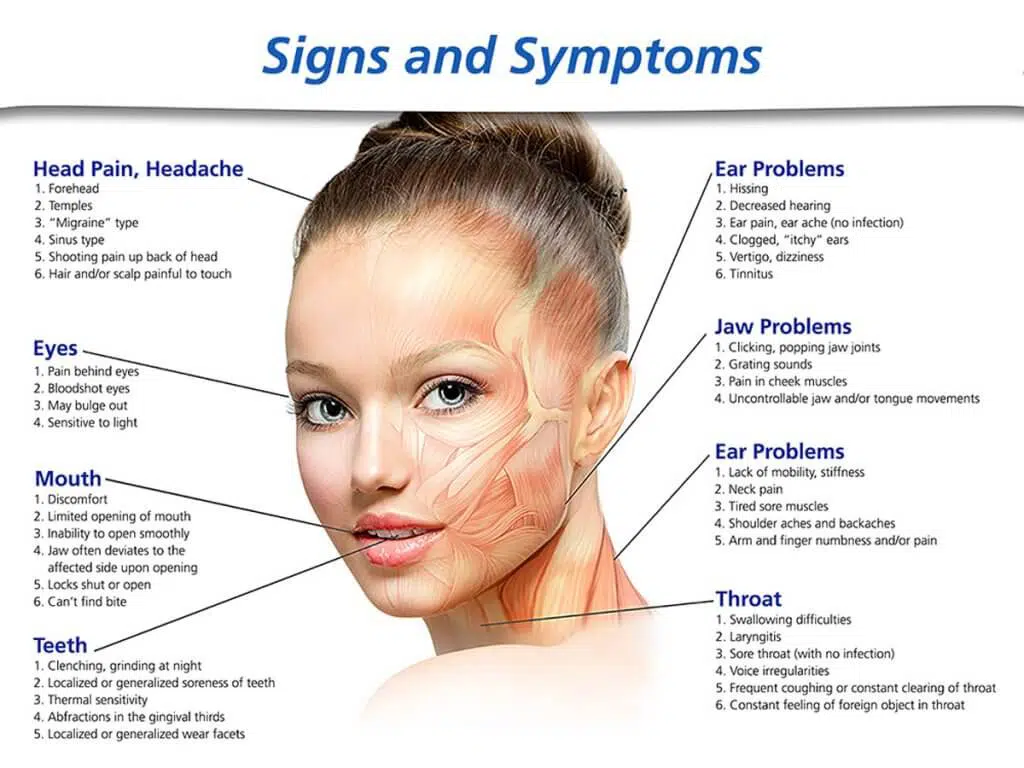
Elite Family Dental Care offers TMJ Treatment in Merrick, NY. To learn more or schedule an appointment, call 516-608-0001.
The temporomandibular joint (TMJ) connects your jawbone to your skull and acts as a sliding hinge whenever you open or close your mouth. Most of us never pay much attention to these joints until they cause discomfort. When TMJ dysfunction leads to chronic pain, it’s called TMJ disorder (TMD), which can make everyday actions like chewing, talking, or even yawning difficult.
Types of TMJ pain
TMJ conditions fall into three main categories:
- Myofascial pain – discomfort or pain in the muscles that control jaw function (grinding teeth can result in this type of TMJ disorder)
- Internal derangement of the joint – a possible indicator of a displaced disc, dislocated jaw, or injury to the condyle
- Arthritis – a degenerative inflammatory disorder
Signs and symptoms of TMJ disorders are frequently intensified by stress and can include:
- Headaches
- Soreness in the cheek or jaw area
- Pain in or around the ears
- Facial pain
- Tight jaws
- Popping or clicking sounds when opening mouth
- Locking of the jaw
- Difficulty chewing
TMJ disorder is often difficult to diagnose because it may manifest as symptoms like headaches and earaches. It’s also difficult to treat because TMD can have a number of causes that require different forms of treatment. It’s critical that you see a dentist who specializes in the diagnosis and treatment of TMJ disorder in order to find lasting relief. For many, Botox has emerged as an effective and noninvasive solution for TMJ pain.
Why Botox for TMJ?
Botox, widely known for its cosmetic use in smoothing wrinkles, is a neuromodulator that temporarily relaxes muscles. When used for TMJ pain, Botox works by reducing muscle tension in the jaw. This helps alleviate the soreness, tightness, and discomfort caused by overly active or strained jaw muscles.
Here are some reasons Botox is gaining popularity as a treatment for TMJ disorders:
- Quick Relief: Botox can provide noticeable relief in as little as a few days after treatment.
- Minimally Invasive: Unlike surgery, Botox is a simple, outpatient procedure requiring no downtime.
- Targets the Source: By relaxing overactive jaw muscles, Botox addresses one of the primary causes of TMJ pain.
- Improves Quality of Life: Many patients report reduced pain and better jaw function, improving their ability to eat, speak, and smile comfortably.
How Does Botox Work for TMJ?
TMJ disorders often involve excessive muscle activity in the jaw, such as clenching or grinding (a condition known as bruxism). This constant tension can lead to pain, headaches, and even damage to the joint.
When Botox is injected into specific muscles, it temporarily weakens their ability to contract. This relaxation reduces tension, relieves pain, and even helps minimize behaviors like grinding or clenching. The treatment is targeted, meaning it only affects the injected muscles, leaving surrounding areas unaffected.
What to Expect During Botox Treatment
Botox treatment for TMJ is straightforward:
Consultation: A dentist or medical professional will evaluate your symptoms to determine if Botox is right for you. They’ll identify the muscles contributing to your TMJ pain.
Injection Process: The procedure involves injecting small amounts of Botox into targeted muscles, such as the masseter (jaw muscle) or temporalis (forehead muscle). The injections are quick and typically painless, with most patients describing the sensation as a small pinprick.
Aftercare: There’s no downtime, and you can resume daily activities immediately. Some mild swelling or redness at the injection site may occur but subsides quickly.
Benefits Beyond Pain Relief
Patients who opt for Botox often notice additional benefits beyond pain reduction:
- Reduced Headaches: If muscle tension from TMJ causes migraines or tension headaches, Botox can provide relief by relaxing those strained muscles.
- Prevention of Future Damage: By limiting muscle overuse, Botox can help protect the jaw joint from worsening damage.
- Improved Jaw Appearance: Botox can subtly slim the jawline by reducing the size of overworked muscles, creating a softer, more relaxed look.
Frequently Asked Questions About Botox for TMJ
How long does Botox last for TMJ?
Results typically last three to four months. Regular treatments can help maintain relief and reduce the frequency of chronic pain.
Is Botox safe for TMJ?
Yes, Botox is FDA-approved for medical use and has a strong safety record. Side effects are rare and usually mild, such as temporary muscle weakness or localized swelling.
Can Botox replace other TMJ treatments?
Botox works best as part of a comprehensive plan. It’s often combined with other treatments, like stabilization splints or physical therapy, for optimal results.
Who is a good candidate for Botox?
Patients with TMJ disorder caused by muscle tension, clenching, or grinding are ideal candidates. If stress-induced jaw pain impacts your quality of life, Botox may be a noninvasive option worth exploring.
Take the First Step Toward a Pain-Free Jaw
TMJ pain doesn’t have to control your life. Botox offers a safe and minimally invasive solution to manage symptoms and improve your day-to-day comfort. If you suffer from chronic jaw pain, headaches, or tightness, consider consulting with a qualified professional to see if Botox could be the answer you’ve been searching for.
To learn more or schedule an appointment, call 516-608-0001.


